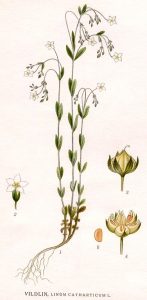Linum catharticum
Lus na mban sí

Carl Axel Magnus Lindman creator QS:P170,Q719778, 220 Linum catharticum, marked as public domain, more details on Wikimedia Commons
Fairy Flax is an annual or biennial herb found in seashore meadows, dry fields, or rocky outcrops or limestone pavement. The 5 petals of the plant are small (4mm), white with light veins and a yellow centre. It flowers from May to September. The flowers droop noticeably when in bloom. The leaves of the Fairy Flax are narrow and oblong and are in opposite pairs that are held upwards close towards the stem.
Fairy Flax can be found across Eurasia from Iceland and Scandinavia to Morocco and has been introduced to North America and New Zealand.
Fairy flax is also known as the “Purging Flax” as it was used as a laxative in the past and as a cure for rheumatism. Fairy Flax contains the toxin Linamarin.
In Irish the name means the “Fairies Herb”, although “Bean sí” is also the female spirt that calls the death of a family member.
In English fairy tales, fairy flax was spun by fairies to make their clothes. Flax is an important resource used in the making of clothes and the linseed has been used for fodder for cattle and also to make poultice for treating boils and respiratory issues.
Featured image by Zoë Devlin